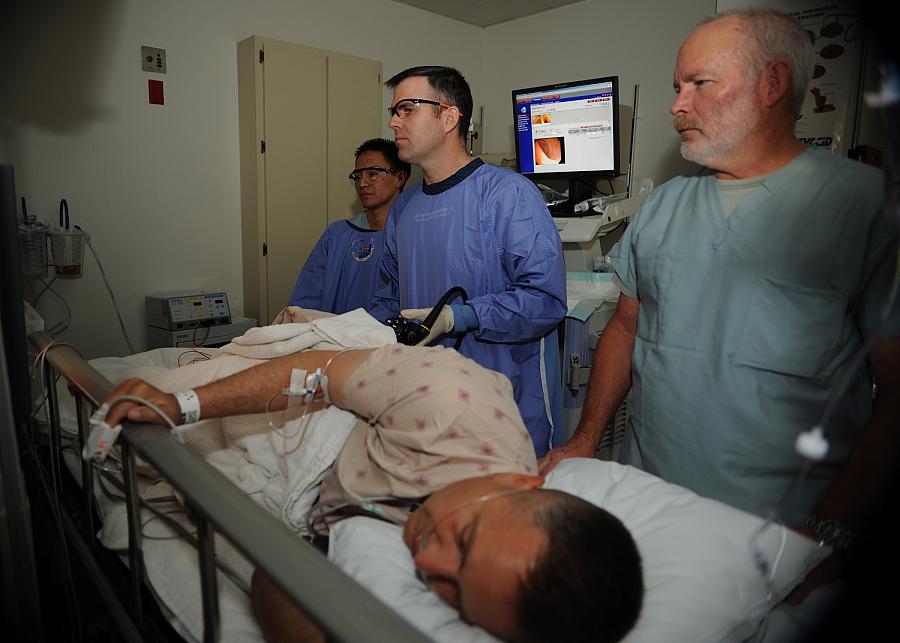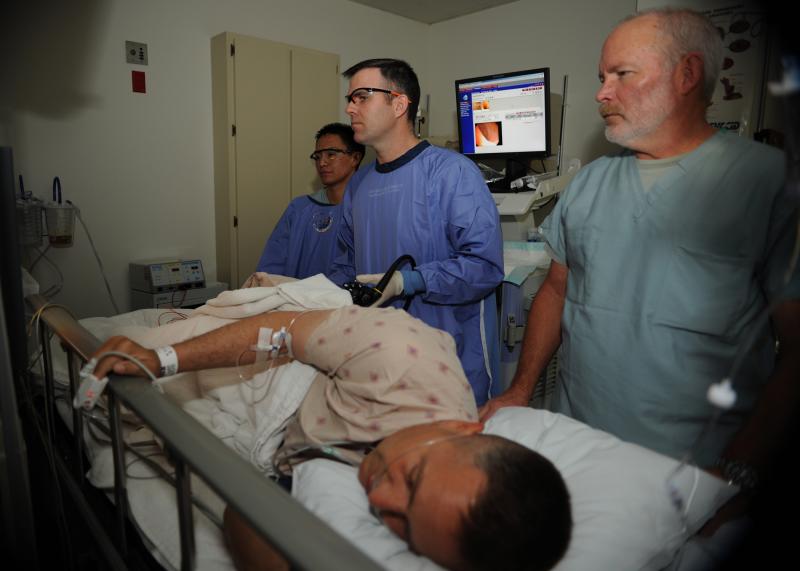Colon cancer screening news coverage all over the map and readers are probably lost

 A couple of studies published in the New England Journal of Medicine (NEJM) don't present as clearcut a picture of colon cancer screening evidence as some stories might suggest.
A couple of studies published in the New England Journal of Medicine (NEJM) don't present as clearcut a picture of colon cancer screening evidence as some stories might suggest.
One study pointed to benefits of colonoscopy screening. Another described potential benefits of a form of blood stool testing called Fecal Immunochemical Testing (FIT). An editorial in the NEJM attempted to give perspective on both studies.
The Los Angeles Times blog didn't even mention the blood stool test (FIT) study. It didn't mention any possible limitations of the colonoscopy study. It didn't even mention that there was an accompanying editorial in the New England Journal that tried to make sense of the two studies.
Similarly, WebMD never mentioned the blood stool test (FIT) study nor the fact that there was a NEJM editorial that addressed both studies.
Bloomberg/Business Week never mentioned the FIT study although it interviewed one of the editorial writers who had addressed both studies in the editorial.
An Associated Press story mentioned both studies, mentioned that the colonoscopy story wasn't a randomized clinical trial as a limitation, but clearly emphasized the colonoscopy finding more than the FIT finding, and quoted an American Cancer Society official saying, "There's no question that these are findings that we can take to the bank," without offering any countering opinion.
A New York Times story was far more complete than either of the previous two mentioned. It offered more discussion of potential limitations of the colonoscopy study, more discussion of the context of tradeoffs among a broader range of colon cancer screening options, and interviewed more sources. However, we wonder what readers are supposed to make of this collection of quotes:
- An Oregon oncologist is quoted calling this "a very robust reduction." It was not explained why she was chosen to comment.
- A Minnesota physician said "This study puts that argument to rest." It was not explained why he was chosen to comment.
- An American Cancer Society spokesman said, "This is a very big deal."
- But Dr. Hal Sox of Dartmouth "cautioned that the new study was not the last word." And he questioned whether the findings would apply to the general population.
The weakest part of the NYT effort, though, was that the FIT study drew only one throwaway line that didn't even address the potential benefits of the blood stool test approach and only referred to the compliance rate. And no mention was made of the NEJM editorial that addressed both studies.
A Reuters Health piece was the only one we saw that took a markedly different approach, leading with the blood stool test finding, emphasizing:
"A new study in the New England Journal of Medicine suggests that a relatively inexpensive and non-invasive test may be just as effective as a colonoscopy."
Reuters was the only news organization I saw that quoted this key line from the NEJM editorial:
In an editorial in the Journal, Dr. Michael Bretthauer of Oslo University Hospital and Dr. Mette Kalager of Telemark Hospital, both in Norway, said that based on the results, "an appealing concept would be to use colonoscopy as a triage screening test, offering it once for everybody at 60 years of age" and using it to classify people into high- and low-risk categories. Low-risk people would not need further screening while those with adenomas would be evaluated regularly.
And it was the only news organization that allowed the Spanish FIT researchers to talk about their study as much as it allowed the colonoscopy researchers to tout their work, including this excerpt from the FIT coverage:
At this point in the study, the researchers concluded, "the numbers of subjects who needed to be screened to find one colorectal cancer were 191 in the colonoscopy group and 281 in the FIT group, and the numbers who needed to be screened to find any advanced (cancer) were 10 and 36."
That's important when the FIT test is so much cheaper than a colonoscopy, Quintero said. "This simple, non-invasive and cheap test is equally good at detecting colorectal cancer and identifying the high-risk individual that should undergo a colonoscopy.
And the complication rate, including bleeding, low blood pressure and slow heartbeat, was nearly five times higher in the colonoscopy group.
From what I've seen today, in my opinion, that Reuters piece was the most balanced and arguably the most helpful to people at home trying to make decisions about colon cancer screening.
I don't have the resources of the Los Angeles Times, the Associated Press, or the New York Times but it didn't take me long to get some thoughtful, helpful analysis from two people I tend to turn to for analysis at times like this.
Harold DeMonaco is Director of the Innovation Support Center at Massachusetts General Hospital and one of our story reviewers on HealthNewsReview.org. He read the studies, the editorial, and some of the news coverage – and, although he was on deadline himself today, he offered this quick analysis:
- Colonoscopy appears to reduce the risk of colon cancer and the risk of dying from it. Unlike other tumors, colon cancer appears to be a bit more homogenous. Early detection and removal of adenomatous polyps appears to reduce the risk of colon cancer. A considerable minority of adults will have adenomatous polyps on colonoscopy (up to 25% of males)
- Good follow up screening in folks who have had an adenomatous polyp removed appears to reduce the risk of dying from colon cancer (based on this well done but observational study) over several decades of observation. Given the slow rate of growth of colon cancer, you would want to see long term outcomes which this study provides
- Fecal immunochemical testing appears to be as useful as a screening tool for colon cancer (over a ten year window). However, FIT is not as good in detecting existing adenomatous polyps
- Given their choice, people appear to favor FIT over colonoscopy but not by that large a margin and again only about 1/3rd actually followed through.
- FIT testing is easier, far less expensive and does not have the rare but important potential complications associated with colonoscopy.
- The right combination of colonoscopy and FIT testing remains unclear as does the role of CT colonoscopy.
Dr. Russell Harris of the University of North Carolina has worked with the US Preventive Services Task Force for a long time and has helped me and other journalists in the past to evaluate screening studies (one classic example here). Dr. Harris wrote me the following:
I think the interpretation of the study is important, and I don't see that in any of the news reports or in the paper/editorial.
- Zauber et al (the colonoscopy study) say that the correct comparison is between a group with adenomas removed and a group with the same adenomas not removed. That is not exactly correct. The best comparison would be long-term cumulative colorectal cancer (CRC) mortality between the 2 groups (one with adenomas removed and one with the same adenomas left in), BOTH OF WHICH RECEIVE THE SAME FUTURE SCREENING (ie, every 10 year colonoscopy or every 2 year FIT, or something that is the same) AND THE SAME FUTURE CRC TREATMENT WHEN THEY ARE DIAGNOSED. The real question here is whether WE NEED TO TAKE OUT THE ADENOMAS NOW OR WHETHER WE WILL GET THE SAME BENEFIT BY JUST MAKING SURE EVERY ONE GETS REGULAR SCREENING. That is why there is an analysis that the authors could have done (maybe did do and didn't report) that would have been helpful. That is, was the reduction in CRC mortality mostly found for the "advanced" adenomas (ie, > 1.0 cm or villous, etc) or also for the little ones (nonadvanced). One would suspect that we get much more from removing the larger ones than the smaller ones. Yet the smaller ones are far more numerous. So it may be that we could get the same benefit by taking out many fewer polyps (ie, only the larger ones), thus reducing costs and harm from biopsy.
- If CRC mortality reduction from polyp removal is small (in an absolute sense) until > 10 years after polypectomy, it raises the issue of whether polypectomy of even the larger adenomas is much better than just waiting until the next screening.
- If CRC mortality in people with nonadenomatous polyps is low after 10 years (Fig 2) – and presumably also low in people with no polyps at all – then it raises the question of whether these people (ie, those with nonadenomatous polyps or no polyps on a screening colonoscopy) ever need another one. This is an issue raised at the end of the editorial. These studies don't answer this question.
- Finally, even if we buy a 50% relative risk reduction from polypectomy, one must take into consideration the harms and costs of this practice before deciding to implement it. Isn't it curious that we are just now getting estimates of the magnitude of risk reduction from colonoscopy when the US adopted a "primary colonoscopy" screening policy years ago? Harms and costs are substantial here, and should be thoughtfully considered.
- The FIT study makes one wonder if a primary FIT strategy would work as well as a primary colonoscopy strategy, at lower cost and with fewer harms.
Why did the majority of news coverage fail to reflect this kind of analysis? I'm not expecting news organizations to publish the depth or length of the comments I posted above. But some of the key concepts that DeMonaco and Harris raise could be summarized easily.
Why did Reuters Health look at the same studies that everyone else did, but take such a markedly different – and I think, better – approach to these studies?
Why were important elements missing from each of the other stories mentioned above?
What editorial decision-making took place that led to some major news organizations completely ignoring the blood stool test study?
Why do journalists choose to overlook editorials that provide immediate easy access to at least one other independent viewpoint?
As we continue to push for improved scrutiny of public messages about screening tests, we urge journalists to reflect on the variation of stories as we've outlined here, and on the analysis provided by the two experts I quoted.
Photo credit: By U.S. Navy photo by Mass Communication Specialist 2nd Class Chad A. Bascom [Public domain], via Wikimedia Commons

